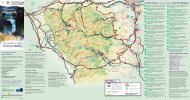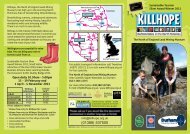How a visit to Killhope can inspire
How a visit to Killhope can inspire
How a visit to Killhope can inspire
Create successful ePaper yourself
Turn your PDF publications into a flip-book with our unique Google optimized e-Paper software.
UNIT 1C: SORTING AND USING MATERIALS<br />
Using <strong>Killhope</strong>: <strong>Killhope</strong> provides an excellent real-life context for this unit. Children <strong>can</strong> <strong>to</strong>uch the<br />
minerals in the Mineral Room, and work <strong>to</strong> sort them just like the children in the nineteenth century.<br />
They <strong>can</strong> see how they are used, and discuss why different materials have been chosen for<br />
different reasons. This hands-on approach will encourage the children <strong>to</strong> take part.<br />
LEARNING OBJECTIVES POSSIBLE ACTIVITIES LEARNING OUTCOMES<br />
• That every material has<br />
many properties, which <strong>can</strong><br />
be recognised using our<br />
senses, and described using<br />
appropriate vocabulary.<br />
• To record observations of<br />
materials.<br />
Handling different materials<br />
• Ask the children <strong>to</strong> handle<br />
a variety of objects on the<br />
siite and ask them <strong>to</strong><br />
describe and record them.<br />
Identifying materials without looking<br />
• Use words, eg hard, shiny,<br />
rough <strong>to</strong> describe<br />
materials and objects.<br />
• To ask questions and <strong>to</strong><br />
explore materials and<br />
objects using appropriate<br />
senses, making observations<br />
and communicating these.<br />
• That there are many<br />
materials and these <strong>can</strong> be<br />
named and described.<br />
• Ask children what senses<br />
they could use <strong>to</strong> find out<br />
what objects are like.<br />
Encourage them <strong>to</strong> use<br />
their other senses <strong>to</strong><br />
identify material, eg this is<br />
lead because it is heavy,<br />
this is fabric because…<br />
Describing different materials<br />
• Present the children with a<br />
collection of familiar<br />
materials, eg wood, metal,<br />
grass, talk <strong>to</strong> them about<br />
the materials and name<br />
them. Ask the children <strong>to</strong><br />
find other objects made of<br />
the same material on site –<br />
there are so many <strong>to</strong> find!<br />
• Ask suitable questions<br />
about objects.<br />
• Describe materials in<br />
terms of senses: eg this<br />
feels smooth<br />
• Name several common<br />
materials and describe<br />
them using terms, eg<br />
rough, hard shiny.<br />
• Identify different objects<br />
made of the same material<br />
and name the material.<br />
36







